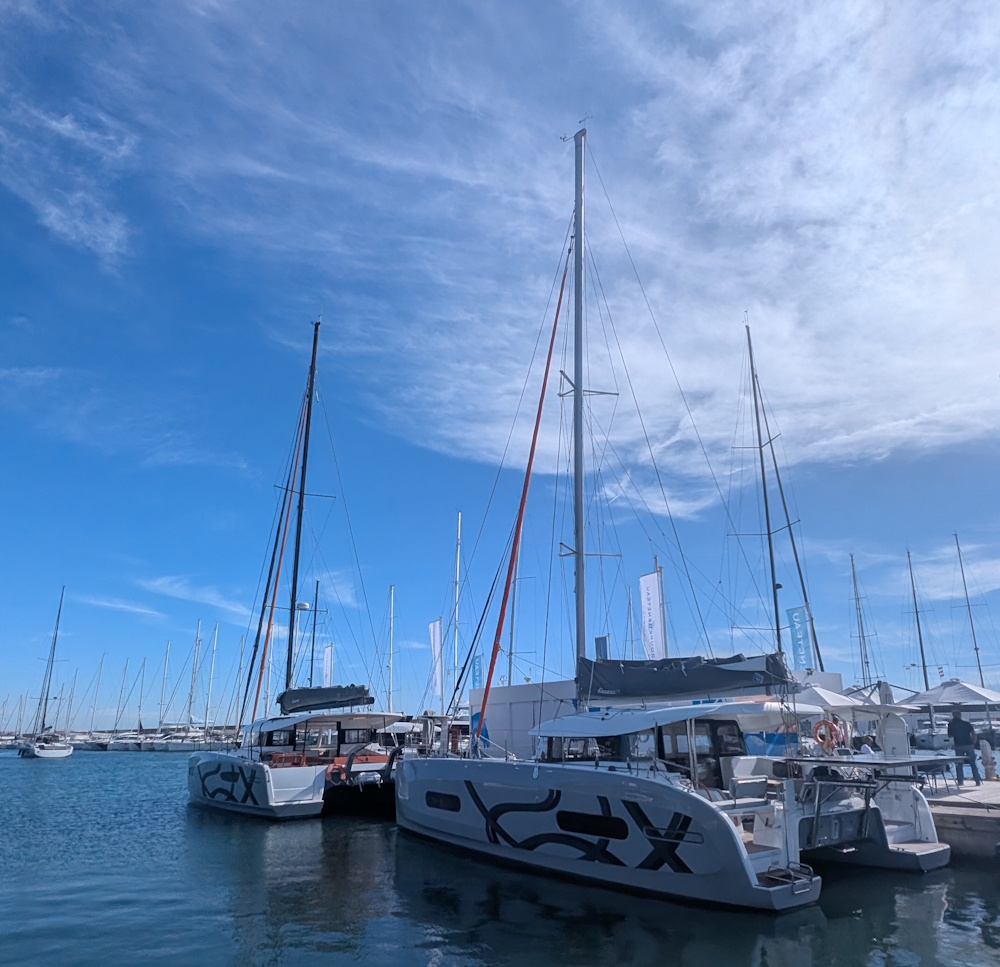Excess 11 Hybrid – the Small cat with the Big Idea

Verdict: the Excess 11 Hybrid takes one of the most successful, compact production cruising cats on the market and gives it a thoughtful hybrid drivetrain (twin electric motors plus a diesel genset).
It’s quieter, cleaner around the marina and anchorages, and crucially designed as an affordable, robust system. That’s what makes this launch stand out.
What’s new, exactly?
The French manufacturer now offers the Excess 11 with a hybrid propulsion pack that pairs twin electric motors with an onboard diesel generator to extend range. We recently tested this version of Excess’s smallest model in Port Ginesta, Spain.

The Excess 11 Hybrid sitting behind an Excess 13 in Port Ginesta near Barcelona
Near-silent manoeuvring in the marina, the ability to cruise under electric power for long stretches, and automatic optimisation between battery, motor, and generator for longer passages. She has dual 10 kW pods, a22 kVA genset, and a 48 V lithium bank).
Testing in bumpy conditions, we hit 7.5 knots at full speed going with the weather and 6.5 knots heading into the chop. Dial the power down to 5kW per engine and you will cruise at 5 to 5.5 knots for up to 5 hours.
The platform is perfect
The Excess 11 itself is compact (LOA ~11.3 m/37 ft; beam ~6.6 m) yet CE-rated for offshore cruising. This “pocket rocket” was designed by VPLP and comes with a square-top main and a new overlapping genoa set-up (previously with a self-tacking jib plan), and a reputation for responsive helming.
That combination – a cruising cat under 12 m with an electric hybrid option – is a first in the market.
You have power for 2 to 5 hours (running at 5kW per engine will extend the range considerable). More than sufficient for outings, manoeuvres and anchorages…
On the water
The 11 Hybrid impressed us with its power and manoeuvrability under engine.
- Docking & tight quarters: instant torque and fine throttle sensitivity make the cat feel lighter on its feet; the quiet means that things remained very calm (note, there wasn’t much wind on the day). The 11 turns on a sixpence.
- Short hops: electric engine pods mean no diesel hum or fumes; you arrive and anchor with batteries ready to be topped up by the solar.
- Passage-making: you still have the “diesel security,” but now the genset is there to feed the system, not drive props directly – allowing for steadier load, better fuel efficiency, and fewer start/stop cycles than running twin mechanical diesels at low RPM. The engines are always on standby mode. You nudge up the throttles and off you go
- Motor Sailing: when the wind is not quite strong enough to sail, you can flip on the leeward engine on low power and bring your apparent wind up for efficient motor sailing without the noise.
Quiet manoeuvres, fully electric cruising when you want it, and optimised hybrid range when you need it.
Availability and maturity
Excess has done alot of legwork on this technology to ensure that its cost effective, robust and makes sense. They have been public about rolling out the hybrid on the 11 from summer 2025, and the brand has banked years of electric know-how from earlier prototypes and collaborations (e.g., Deep Blue on the Excess 15 testbed).
The competition
Hybrid and electric options are arriving on cruising cats, and some brands like Fountaine Pajot and Leopard now have hybrid versions in theri range. But at 37 ft, hybrid choices are very limited; the Excess 11 is the first to make this an option at this size/price band.
A real differentiator for sailors who want the tech in a smaller, more responsive platform that’s easier (and cheaper) to berth. This solution feels like the most practical solution on the market.
The Cost
The hybrid version is about €80,000 more the standard twin-diesel. But compared with a diesel boat upgraded with the lithium house bank + genset, your difference drops to €50,000.
You’re paying an affordable premium for electric propulsion (the ability to motor quietly, integrate energy across the boat, and reduce diesel hours), plus the system integration that come with a factory package.
I pressed Hervé Piveteau, the Product Director, on whether he thought that there were cost savings to be had on the hybrid model. He wouldn’t commit without a couple of years of data, but it seems likely to me that this system will be easier to maintain and may even hold its value better on the second hand market.
Time will tell. The advantages are plentiful:
- High marina/anchorage time, short coastal legs: value is high (noise, comfort, neighbour goodwill, and reduced engine maintenance).
- Long motoring in light airs: advantage narrows; the genset still burns fuel, though at steadier, more efficient loads than twin diesels.
- Charter fleets: quieter operations and simplified daily checks are attractive; eventual resale may benefit from being a “factory hybrid,” not a retrofit.
Pros & Cons
Upsides
- Quiet, precise low-speed handling and quiet nights at anchor.
- Centralised energy system that powers both house and drive, simplifying power planning.
- Beneteau Group design, integration, and support – good for maintenance and resale.
- Underwater Pods : Electric engines are directly connected to the propeller. No mechanical transmission – direct power, without loss!
- Natural Cooling : Beneath the hulls = cooling by seawater. Less noise, less vibration, and less maintenance.
- Low Voltage (48 V) : No need for high-voltage certification during gmaintenance.
- Intelligent Energy Management : Intuitive software tracks energy consumption in real time.
Considerations
- Added weight and complexity (batteries, cooling, power electronics). Around 500kg
- Learning curve with energy management. The system seems very intuitive.
- Real-world electric-only range at cruising speed is finite; this hybrid system is about how you manage and minimise your diesel use, not eliminate it.
Summary
The Excess 11 Hybrid is a great option in this market segment. It sets a middle path: electric where it makes sense, diesel where it’s needed – on a boat that punches above its weight for space and sailing feel. Hybrid electric isn’t just for 50-footers anymore.
| Excess 11 Hybrid — Specifications & Key Features | ||
|---|---|---|
| Hybrid Propulsion System | ||
| Electric Motors | 2 × 10 kW | POD underwater drive |
| Generator | 22 kVA | Diesel genset |
| Charger / Inverter | 8 kVA | Integrated power management |
| Lithium Batteries | 4 × 230 Ah + 4 × 230 Ah | Balanced configuration |
| Factory hybrid system for quiet, emission-reduced cruising and seamless diesel-electric management. | ||
| Sails | ||
| Square-Top Mainsail | 58 m² | 624 sq ft |
| Self-Tacking Jib | 28.5 m² | 301 sq ft |
| Code 0 (Option) | 52 m² | 560 sq ft |
| Upwind Sail Area | 86.5 m² | 925 sq ft |
| Upwind Sail Area – Pulse Line | 93 m² | 1,001 sq ft |
| Dimensions | ||
| Overall Length | 11.42 m | 37′ 5″ |
| Hull Length | 11.33 m | 37′ 2″ |
| Beam | 6.59 m | 21′ 7″ |
| Air Draft | 17.27 m / 18.26 m | 56′ 8″ / 59′ 1″ |
| Draft | 1.15 m | 3′ 9″ |
| Light Displacement (CE) | 9 t | 19,845 lb |
| CE Certification | A: 8 • B: 12 • C: 16 • D: 20 | |
| Equipment & Tankage | ||
| Fresh Water Capacity | 300 L | 79 US gal |
| Holding Tank Capacity | 160 L | 42 US gal |
| Fuel Capacity | 2 × 200 L | 2 × 53 US gal |
| Standard Diesel | 2 × 29 HP | |
